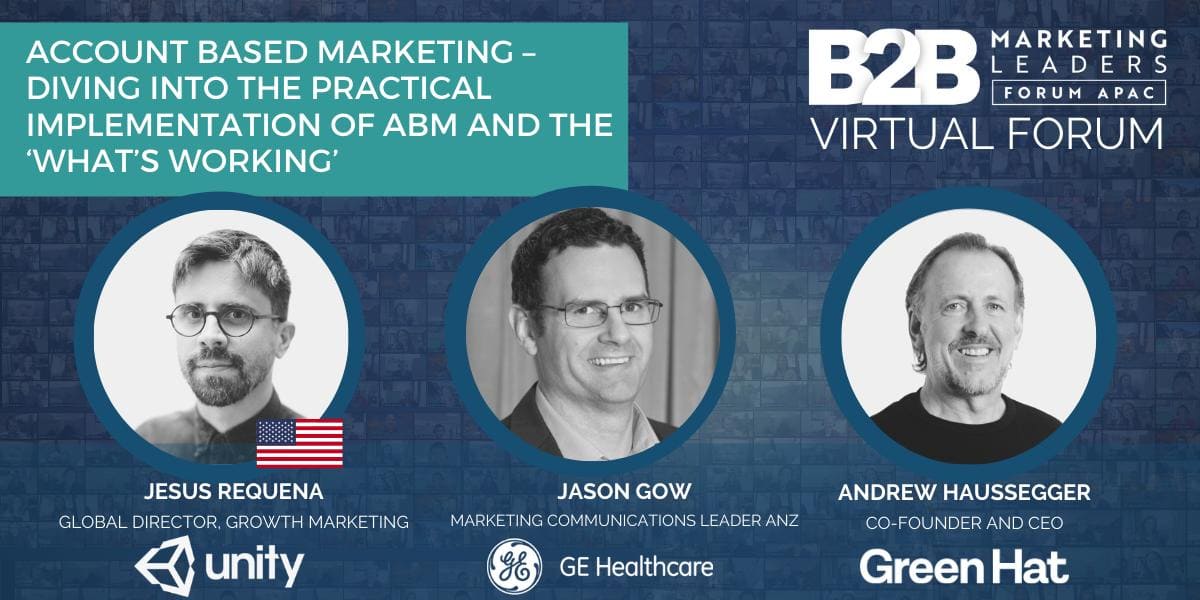Leading ABM practitioners discuss some of the burning issues in planning and implementing ABM in their organisations

Recently, I hosted a panel discussion on ABM with two seasoned B2B marketers at a B2B Marketing Leaders Forum event – one of the many that has metamorphosed from a physical event to a virtual one. During the session, we took questions from the audience but did not get to answer many due to time.
So here is a follow-up where we dive into a selection of those.
Our panellists were Jesus Requena, Global Director of Growth Marketing at Unity Technology (based in San Francisco, USA). Unity provides the world’s leading platform for creating and developing interactive 3D content and Jason Gow, Marketing Communications Leader, GE Healthcare (based in Melbourne, Australia). GE Healthcare is a leading global medical technology and life sciences company.
The session was titled ‘Diving into the Practical Implementation of ABM and What’s Working’. We specifically did not want to talk ‘theory’ but instead hear about what they have been doing on the ground to stand-up their ABM and drive return for their sales teams and organisations.
Let me start with a key question that got some attention in the session.
Paraphrased:
What is actually different about ABM compared to what we are doing today?
- Targeting. Today we target segments based on factors such as demographics, firmographics and behaviours. ABM obviously targets by nominated accounts, and uses tech and data to hyper-personalise these accounts.
- Buying Party. B2B marketing focuses on individual leads. We identify, track and progress leads, MQLs, SALs, SQLs etc. However ABM focuses on the ‘buying party’ – the collection of individuals who decide, recommend and influence decisions. Footnote: in ABM, it’s more valuable to have multiple buying party contacts high in the funnel than just one MQL/SAL deeper in the funnel.
- Active Demand. ABM focuses on identifying interest and intent to purchase by tracking what the buying party is searching for and consuming across the web, as well as with your own content – not an approach generally taken today in segment marketing.
- Data Strategy. Best-practice ABM requires an underpinning data strategy. We start the process by considering what is the information we need to see in the Account View
- Account Insights. Realtime account insights are shared with field sales, inside sales and marketing to dynamically track the account’s buying party, intent signals, engagement and milestone events. Sales use this dashboard on a weekly basis to guide their account penetration and pursuit.
NOTE: If you are interested in B2B and ABM research, visit our B2B marketing research page to download the latest B2B marketing report that talks to the state of ABM adoption. Let’s get into some of the specific questions from the audience on the day.
What are the organisational prerequisites before embarking on ABM? For example, sales account coverage, marketing cooperation, and sales and marketing platform integrations?
JESUS: There are many and it’s important to note that ABM is not for everyone.
- It’s for accounts with growth potential, deals on average starting at $150K and that will grow over time. A benchmark deliverable for ABM is to grow the deal size which we have been doing at Unity, when compared to non-ABM account deals.
- It’s for long sales cycles – not for transactional fast-turnaround opportunities.
- It’s typically used for new logos, and mainly for expansion accounts.
- It requires enough content to personalise account journeys – if not an account level (for personalisation) then at least at a use-case / industry level.
ABM is a transformational process, and as such requires CxO sponsorship and Sales commitment. There are additional needs to run ABM – with technology platforms and data services being the main areas of external investment.
How do you determine the right target accounts for ABM targeting?
- Missing out on deals you could have won. If you leave prime candidates off of your account list, you’re needlessly ceding big deals to the competition.
- Wasting effort on a poor fit – put the wrong accounts on your list and you’ll spend time, money and effort on low-potential opportunities while under-resourcing your best shots.
- Where have we sold most effectively in the past?
- Which kinds of accounts have delivered the best CLV (customer lifetime value) as well as strategic value?
- What characteristics are most predictive of sales success?
- What traits rule out an account?
- Which accounts do we already have an advantage and level of engagement?
- Understand what accounts have high propensity to grow (expand), and greater velocity.
- Define firmographics, technographics, intent and buying signals of those accounts.
- Work with data vendors to find all look-a-like accounts (beyond your customers) that you should target based on #2.
- Score accounts based on those three ‘account fit’ areas – firmographics, intent and buying signals.
- Select your top 100-200 accounts (depending on sales team size) to go after.
You may need to start broader with a 1toFew or 1toMany approach, with an intent to move some of those accounts to a 1to1 model overtime.
I have a list of target accounts but one of my top challenges in ABM is how to get the contact details and how to engage with the key decision makers. Do you recommend using a third party data provider to get those contact details?
JASON: Before you go to a third party list, I would recommend employing progressive profiling tactics to try to build contact details over a period of time. There is a lot of info on this via some of the leading automation platform providers such as Adobe/Marketo and Salesforce/Pardot. If you are looking to beef this up, then yes use a third party to help build contact information. Look for solutions that can easily push into your CRM.
What was the Sales team’s response or acceptance to ABM?
Choosing the right team to carry out the planning and the plays – so what resources will be allocated to each part of the program (and that will vary from account to account).
Today with the work we are doing on ABM, Sales and Marketing departments are on the same page, talking to each other and communicating and common goals – but still acting independently from each other. It’s a baton handoff; each department does its own thing, but in a coordinated fashion.
The goal for us though is to get to a more modern style of Sales and Marketing collaboration. Where Marketing takes a stronger leadership role, activating Sales at the right time in order to move the business forward (especially when a human touch is required).
As Marketing acts as an orchestra conductor, gently nudging Sales to take the right actions. Or, to use a sports analogy, Marketing acts like the half back in rugby, calling the right plays that prompt the entire team to act.
JESUS: In addition to Jason’s points, ABM is driven by three key organisations, being Product, Sales, Marketing (product marketing and demand generation). These three teams need to agree on what are the goals for the year, and if ABM is the right solution to achieve those goals. If Sales leadership understands that ABM will work on a set of accounts they are targeting, the rest is a matter of proper execution.
This will take effort and time, and where Marketing adds value is normally in understanding the TAM (total addressable market), pain points and how your solutions solve those. Product Marketing and Demand Gen are critical in demonstrating the value of Marketing to sales, their understanding of the ICP (ideal customer profile), their intent signals, and behavioral signals to increase sales efficiency.
What tech stack do you use to track and report on your ABM efforts?
- Data provision/collection
- Awareness
- Content infrastructure
- Acquisition
- Enrichment
- Nurture
- Conversion/Attribution
- ABM infrastructure
Some key platforms are 6sense and Terminus for specific ABM functionality, Brightfunnel for Attribution, then data from SFDC and Eloqua exported into our Google Cloud Platform. We visualise data from there in custom dashboards.
JASON: For our 1to1 strategy, we use a combination of platforms though Marketo and SFDC as the core ones. In Marketo we use the Revenue Explorer report that displays interactions by account and ties back to revenue generated. With SFDC we have created a dashboard for each account that picks up new opps created, total open opps (pipeline) and closed deals. We also measure velocity as well using this platform. Lead-to-Account matching is currently done manually.
How important is LinkedIn for your ABM process?
Author’s Comment: LinkedIn is the #1 B2B social media platform and must be considered for engagement with the buying party in ABM programs. When would you not use LinkedIn? When the audience either is not there, or is not active there. You can size the audience using LinkedIn Campaign Manager. As with all social media marketing, we recommend you adopt a test/learn approach, and unless you already have a large engaged audience – it’s a pay-to-play model.
Check out the preferred B2B social platforms in the B2B research report here.
What is the purpose of an ABM Playbook and why develop one?
I’ll chip in here guys!
We’ve all heard about Sales and Marketing alignment – finding ways to have both teams working hand in glove as one. There is no other aspect of B2B marketing where this is more important than for ABM. Marketing needs to do all it can to get the attention and engagement of the buying party of the target account, and to ensure the Sales team has visibility of that engagement in (almost) realtime.
The ABM program playbook is a jointly developed guidebook with ‘sequences’ or steps to guide the Sales team (inside and field) with steps to engage the buying party. It typically will outline a 30-60 pursuit recommending the cadence for using key channels, being email, phone, LinkedIn and direct-mail. The playbook provides links to recommended content to use at different stages of the engagement, and provides links to Account View dashboards and other key account data.
Why develop one? We are looking for scalability, repeatability and consistency. Without the playbook, Sales (especially Inside Sales) are left to ‘custom-build’ their own processes, leading to key messaging, content and engagement opportunities being missed.
Jason, how did you determine what the customer interest areas were? Was it just based on what they were searching for, or were you able to get deeper information so that you could customise the content based on their interest areas?
- Knowledge and understanding of my unique business issues.
- Knowledge and understanding of my industry.
- Fresh ideas to advance my business.
- It’s content driven – not product-led.
- It’s helpful and valuable – providing real utility to the audience.
- It’s focused on the buyer – not your company’s agenda.
- Full account profiles – top decision makers and influencers.
- Quarterly updates – All reports combined.
- Dedicated insight team per account – Working Group.
- Weekly snapshot alerts per account – SFDC.
- Reverse IP lookup technology reviews.
This has been key in determining what content we produce and how we pivot mid-campaign.
- We prioritize themes and issues for the account based on our insight.
- Identify sources: subject matter experts, existing content, etc.
- Create an editorial calendar for content creation.
- Create content briefs and assign to internal team.
Conclusion:
In our view, the term ABM is a misnomer. At Green Hat, we refer to ABM as ABE – Account-Based Everything. It is the evolution of Account-Based Sales and Target Marketing into an approach that is ‘account-centric’. It epitomises the transformation B2B marketers are taking from a focus on individual leads to collective buying parties.
A theme in the above Q&A talks to Sales, Marketing and other customer-facing teams working in unison to engage specific accounts using an integrated framework of data, technology, channels, hyper-personalisation and performance reporting.
Data and technology now provide exciting new account targeting opportunities. B2B firms now need to understand what’s in it for them – if they have not already.







